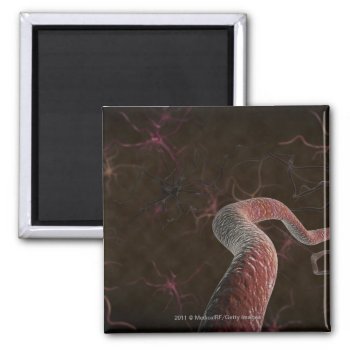Neurons Copyright: MedicalRF.comA neuron ( / ˈ nj ʊər ɒ n / NEWR -on ; also known as a neurone or nerve cell ) is an electrically excitable cell that processes and transmits information by electrical and chemical signaling. Chemical signaling occurs via synapses , specialized connections with other cells. Neurons connect to each other to form neural networks . Neurons are the core components of the nervous system , which includes the brain , spinal cord , and peripheral ganglia . A number of specialized types of neurons exist: sensory neurons respond to touch, sound, light and numerous other stimuli affecting cells of the sensory organs that then send signals to the spinal cord and brain. Motor neurons receive signals from the brain and spinal cord, cause muscle contractions , and affect glands . Interneurons connect neurons to other neurons within the same region of the brain or spinal cord. A typical neuron possesses a cell body (often called the soma ), dendrites , and an axon . Dendrites are thin structures that arise from the cell body, often extending for hundreds of micrometres and branching multiple times, giving rise to a complex “dendritic tree”. An axon is a special cellular extension that arises from the cell body at a site called the axon hillock and travels for a distance, as far as 1 m in humans or even more in other species. The cell body of a neuron frequently gives rise to multiple dendrites, but never to more than one axon, although the axon may branch hundreds of times before it terminates. At the majority of synapses, signals are sent from the axon of one neuron to a dendrite of another. There are, however, many exceptions to these rules: neurons that lack dendrites, neurons that have no axon, synapses that connect an axon to another axon or a dendrite to another dendrite, etc. All neurons are electrically excitable, maintaining voltage gradients across their membranes by means of metabolically driven ion pumps , which combine with ion channels embedded in the membrane to generate intracellular-versus-extracellular concentration differences of ions such as sodium , potassium , chloride , and calcium . Changes in the cross-membrane voltage can alter the function of voltage-dependent ion channels . If the voltage changes by a large enough amount, an all-or-none electrochemical pulse called an action potential is generated, which travels rapidly along the cell's axon, and activates synaptic connections with other cells when it arrives. With the exception of neural stem cells and a few other types of neurons, neurons do not undergo cell division . In most cases, neurons are generated by special types of stem cells . Astrocytes , a type of glial cell , have also been observed to turn into neurons by virtue of the stem cell characteristic pluripotency . In humans, neurogenesis largely ceases during adulthood—only for two brain areas, the hippocampus and olfactory bulb , is there strong evidence for generation of substantial numbers of new neurons.Description above from the Wikipedia article Neuron, licensed under CC-BY-SA full list of contributors here. This page is not affiliated with, or endorsed by, anyone associated with the topic.
Continue reading
Tag Archives: age bracket
Sphynx (7 months old) tees
Animals->Cat The Egyptian pyramids are ancient pyramid-shaped masonry structures located in Egypt . There are 138 pyramids discovered in Egypt as of 2008. Most were built as tombs for the country's Pharaohs and their consorts during the Old and Middle Kingdom periods. The earliest known Egyptian pyramids are found at Saqqara , northwest of Memphis . The earliest among these is the Pyramid of Djoser (constructed 2630 BCE–2611 BCE) which was built during the third dynasty . This pyramid and its surrounding complex were designed by the architect Imhotep , and are generally considered to be the world's oldest monumental structures constructed of dressed masonry . The estimate of the number of workers it took to build the pyramids have a wide range from a few thousand, twenty thousand, and up to 100,000. The most famous Egyptian pyramids are those found at Giza , on the outskirts of Cairo . Several of the Giza pyramids are counted among the largest structures ever built. The Pyramid of Khufu at Giza is the largest Egyptian pyramid. It is the only one of the Seven Wonders of the Ancient World still in existence. Description above from the Wikipedia article Egyptian pyramids, licensed under CC-BY-SA full list of contributors here. This page is not affiliated with, or endorsed by, anyone associated with the topic.
Continue reading


